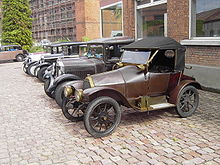SA Mathis
| SA Mathis
|
|
|---|---|
| legal form | Société Anonyme |
| founding | 1910 |
| resolution | 1954 |
| Reason for dissolution | Sale to Citroën |
| Seat | Strasbourg , France |
| management | Émile Mathis |
| Branch | Automobile manufacturer |
Mathis was an automobile manufacturer based in Strasbourg , Alsace . Alsace belonged to the German Empire until 1918 , then to France .
prehistory
Émile Mathis (also Emil Mathis ) had owned the Auto-Mathis-Palace company since 1898 , where he sold, maintained and repaired automobiles. From 1901 he was the general agency of the De Dietrich automobile manufacturer in Strasbourg.
This led to a friendly contact with Ettore Bugatti , who worked as a designer for De Dietrich at the Niederbronn plant from 1902 to the beginning of February 1904 . After De Dietrich wanted to limit himself to his automobile production in Lorraine , the two decided to manufacture a motor vehicle themselves. A corresponding agreement was signed on April 1, 1904. The vehicles were marketed as Hermes Simplex . During the next two years, the model was produced in very limited numbers. From 1906 on, relations between Émile Mathis and Ettore Bugatti deteriorated. The two young people ended their collaboration.
Company history
In 1910, Émile Mathis founded EEC Mathis and again manufactured vehicles that were now marketed as Mathis. Cars, delivery vans and trucks were built. After the end of the First World War , the company was converted into a stock corporation (SA) . In 1934 a joint venture under the brand name Matford was closed with Ford Société Anonyme Française ( Ford SAF ) , which existed until 1940.
American Mathis built some vehicles under license between 1930 and 1931 . Between 1949 and 1952 tractors were manufactured under license from Minneapolis-Moline under the brand name Mathis-Moline . Automobile production ended in 1950. In 1954, Émile Mathis sold the factory to Citroën .
vehicles
In the case of the first cars, the palette ranged from the small four-cylinder model with a displacement of around 900 cm³ to the large-volume in-line eight-cylinder model. The Weymann bodies also offered were a special feature; Instead of a sheet metal planking of the wooden frame, these used a covering made of oilcloth, horsehair and synthetic leather as a surface. This construction offered enormous weight advantages.
Until 1914 Mathis motor vehicles took part in numerous races. It was mainly series vehicles that were equipped with a lighter body. They proved their reliability and competed in the ACF Grand Prix in Dieppe in 1912 and the French Grand Prix in Le Mans in 1913.
literature
- Harald H. Linz, Halwart Schrader : The International Automobile Encyclopedia . United Soft Media Verlag, Munich 2008, ISBN 978-3-8032-9876-8 .
- George Nick Georgano (Editor-in-Chief): The Beaulieu Encyclopedia of the Automobile. Volume 2: G – O. Fitzroy Dearborn Publishers, Chicago 2001, ISBN 1-57958-293-1 . (English)
- George Nick Georgano: Cars. Encyclopédie complète. 1885 à nos jours. Courtille, Paris 1975. (French)
Web links
- GTÜ Society for Technical Monitoring mbH (accessed on March 14, 2013)
- www.mca.at.vu Mathis Club Austria ( page no longer available , search in web archives )
- detailed website about Mathis automobiles (French, accessed on March 14, 2013)
- Mathis Club ( Memento of March 21, 2004 in the Internet Archive ) (French and partly in German, accessed on March 14, 2013)
- Information about the Matford vehicles (French)
Individual evidence
- ↑ Harald H. Linz, Halwart Schrader : The International Automobile Encyclopedia . United Soft Media Verlag, Munich 2008, ISBN 978-3-8032-9876-8 .
- ^ A b c Georgano: The Beaulieu Encyclopedia of the Automobile.
- ^ Georgano: Cars. Encyclopédie complète. 1885 à nos jours.
- ↑ Chester Peterson, Rod Beemer: Minneapolis-Moline Farm Tractors. (English, accessed March 14, 2013)




